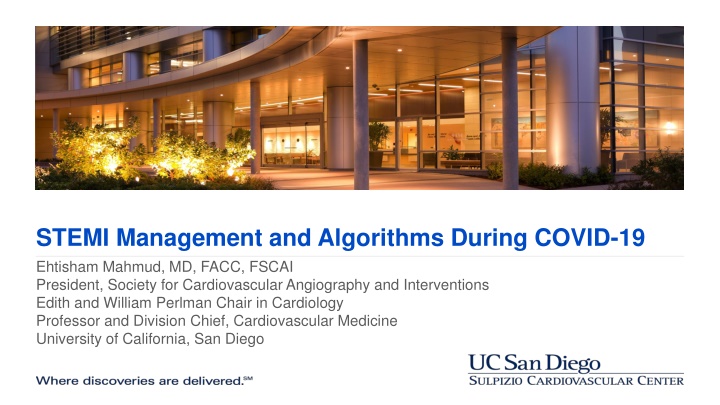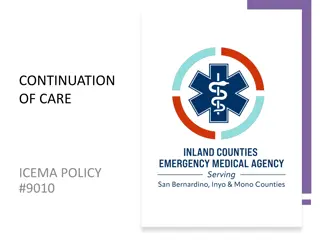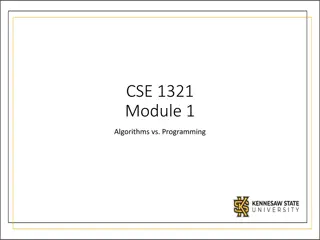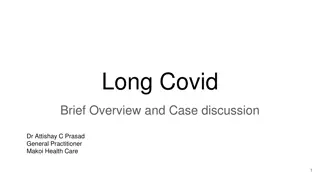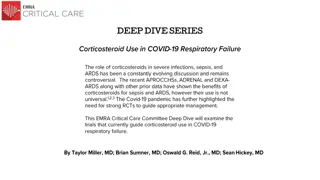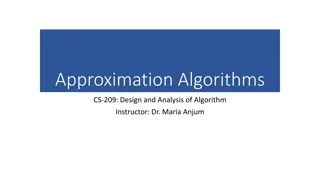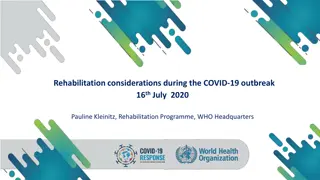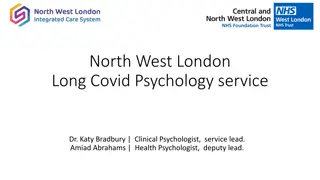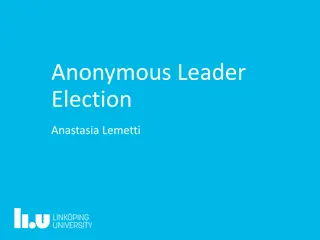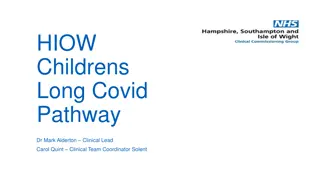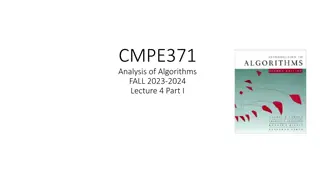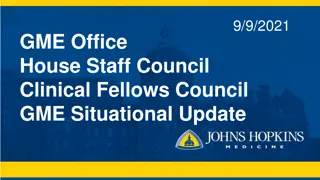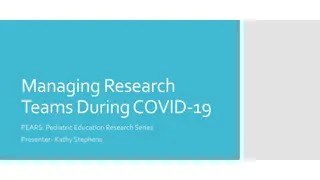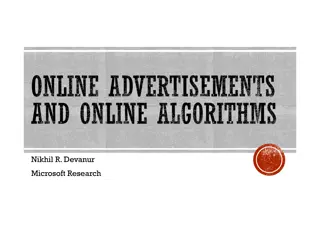STEMI Management and Algorithms During COVID-19
This consensus statement provides guidance on managing ST-Elevation Myocardial Infarction (STEMI) patients during the COVID-19 pandemic. It outlines key considerations for evaluation, treatment strategies, procedural precautions, and post-procedure care to optimize outcomes. Emphasizing the importance of primary percutaneous coronary intervention (PCI) as the preferred approach, the document also addresses challenges such as delays in treatment and resource utilization amid the pandemic.
Download Presentation

Please find below an Image/Link to download the presentation.
The content on the website is provided AS IS for your information and personal use only. It may not be sold, licensed, or shared on other websites without obtaining consent from the author.If you encounter any issues during the download, it is possible that the publisher has removed the file from their server.
You are allowed to download the files provided on this website for personal or commercial use, subject to the condition that they are used lawfully. All files are the property of their respective owners.
The content on the website is provided AS IS for your information and personal use only. It may not be sold, licensed, or shared on other websites without obtaining consent from the author.
E N D
Presentation Transcript
STEMI Management and Algorithms During COVID-19 Ehtisham Mahmud, MD, FACC, FSCAI President, Society for Cardiovascular Angiography and Interventions Edith and William Perlman Chair in Cardiology Professor and Division Chief, Cardiovascular Medicine University of California, San Diego
Management of Acute Myocardial Infarction During the COVID-19 Pandemic: A Consensus Statement from the Society for Cardiovascular Angiography and Interventions (SCAI), American College of Cardiology (ACC), and the American College of Emergency Physicians (ACEP) Mahmud, E, Dauerman, HL, Welt, FG, Messenger, JC, Rao, SV, Grines, C, Mattu, A, Kirtane, AJ, Jauhar, R, Meraj, P, Rokos, IC, Rumsfeld, JS and Henry, TD. Management of Acute Myocardial Infarction During the COVID 19 Pandemic. Catheter Cardiovasc Interv and J Am Coll Cardiol 2020. Accepted Author Manuscript. doi:10.1002/ccd.28946
ST-Elevation on Electrocardiogram COVID-19 Positive/probable COVID-19 Possible Ultrarapid COVID-19 Testing (if available) Symptoms consistent with MI ECG consistent with MI Symptoms consistent with MI ECG consistent with MI Any equivocal symptoms Atypical ECG Echocardiogram to detect WMA Serial ECG, Portable CXR Consider COVID-19 myocarditis Unclear Consider POCUS to confirm WMA ED/IC joint decision regarding coronary CT angiogram or CCL activation STEMI STEMI PRIMARY PCI*
Care of the Acute MI Patient During COVID Care of the Acute MI Patient During COVID- -19 19 All STEMI patients should initially undergo evaluation in the Emergency Department. CCL staff and physicians should have appropriate PPE for safe performance of the procedure, including gowns, gloves, full face mask and an N95 respiratory mask. Patients with respiratory compromise should be intubated prior to arrival in the CCL if possible. Proper PPE training should be provided and practiced by physicians and CCL staff involved in all cases. Primary PCI should remain the default strategy in patients with clear evidence of a STEMI; if a Primary PCI approach is not feasible, a pharmacoinvasive approach may be considered. During the COVID-19 period, there may be delays in D2B times that result from evaluation and/or management of COVID-19 patients which should be documented. Within the CCL, a single negative pressure procedure room with essential supplies only is preferable for the care of known COVID-19 positive or probable patients with a terminal clean after the procedure. To preserve ICU beds, all hemodynamically stable STEMI patients following PCI should be admitted to an intermediate care telemetry unit with plan for early (<48 hours) discharge. Mahmud E, et al. J Am Coll Cardiol and Catheter Cardiovasc Interv 2020 doi:10.1002/ccd.28946
EMS Field STEMI COVID-19 Unknown Emergency Department Evaluation COVID-19 Screening Focused H & P Pulse oximeter and chest X-ray findings Consider COVID-19 myocarditis Ultrarapid COVID-19 testing (if available) STEMI Evaluation STEMI & COVID-19 Positive/probable STEMI & COVID-19 Possible Attending-attending communication on COVID-19 screening Standard STEMI care; document reasons for any delay Dedicated COVID-19 Cath Lab Non COVID-19 Cath Lab Universal use of PPE for aerosolized and droplet precautions in STEMI Universal use of PPE for aerosolized and droplet precautions in STEMI Arrange for ICU isolation bed
STEMI at Referral Hospital (non-PCI) COVID-19 Possible COVID-19 Positive/probable Discussion with Transfer Hospital MD Consider pre-transfer fibrinolysis based on clinical status, transfer delays, team-specific details Receiving Hospital Evaluation (ED or ICU) COVID-19 Re-screening Opportunity Ultrarapid COVID-19 Testing (if available) Fibrinolysis PCI Fibrinolysis PCI Primary PCI Primary PCI STEMI & COVID-19 Positive/probable Consider COVID-19 myocarditis Confirm STEMI diagnosis STEMI & COVID-19 Possible Dedicated COVID-19 Cath Lab Non COVID-19 Cath Lab Universal use of PPE for aerosolized and droplet precautions in STEMI Arrange for ICU isolation bed Universal use of PPE for aerosolized and droplet precautions in STEMI Mahmud E, et al. J Am Coll Cardiol and Catheter Cardiovasc Interv 2020 doi:10.1002/ccd.28946
Emergency Medical Services, STEMI Referral Emergency Medical Services, STEMI Referral Hospitals and PCI Centers Hospitals and PCI Centers Each regional STEMI system should update their system of care immediately to maximize patient and provider safety including adequate PPE during transport and procedures for STEMI patients who are COVID-19 positive or probable. First medical contact to reperfusion time remains of paramount importance and should not substantially delay primary PCI for STEMI patients. Additional time at the Primary PCI center ED or ICU may be a necessary delay required for confirmation of COVID-19 and STEMI status prior to transfer to the CCL. STEMI patients with cardiogenic shock and/or resuscitated cardiac arrest should still be prioritized for a primary PCI approach. If timely PCI is not possible or team/room/PPE not available, a pharmacoinvasive strategy may be considered. It is critical to ensure PPE and rapid sterilization procedures are prioritized throughout the entire system of care and that communication occur among transfer hospital, EMS, ED and CCL providers regarding COVID-19 status. Mahmud E, et al. J Am Coll Cardiol and Catheter Cardiovasc Interv 2020 doi:10.1002/ccd.28946
